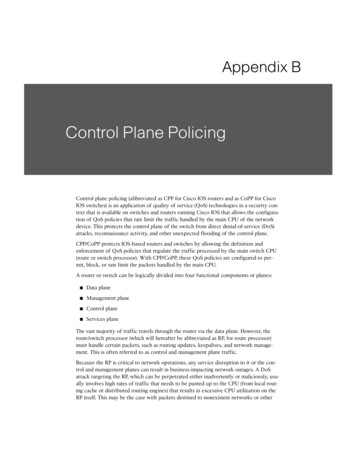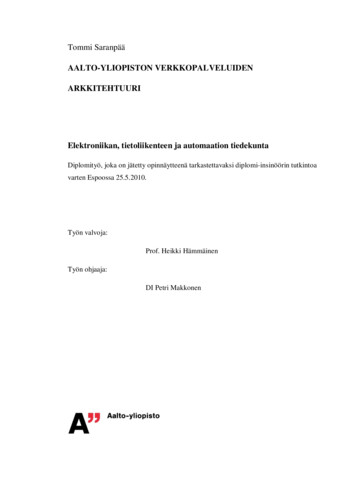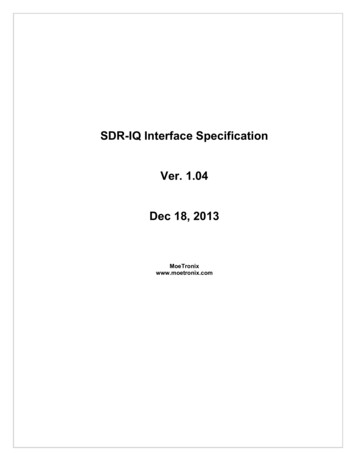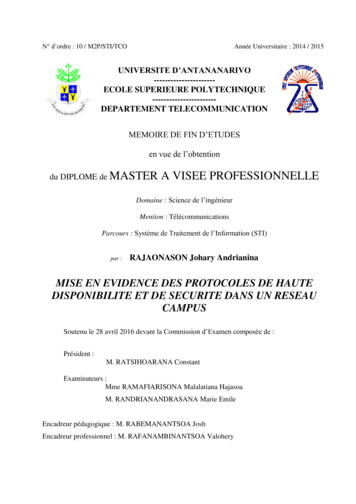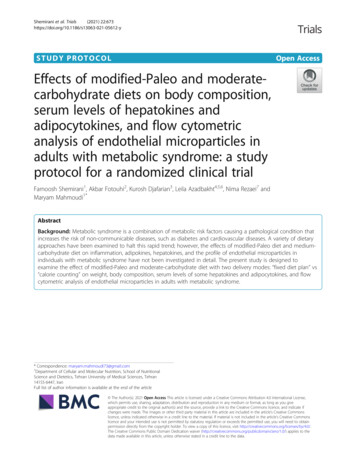
Transcription
, fullness, and desire to eat. To fulfill this, a VASquestionnaire will be given to each participant to fillthem every 2 weeks at home. Finally, to perform biochemical measurements, 10-ml overnight fasting venousblood samples will be collected from each participant,and to isolate circulating EMPs from platelet-poorplasma (PPP), 5 ml of venous citrated blood will be obtained from each patient. All personal information of theparticipants will be confidential in the whole study. Outcome assessors will be blinded to the intervention assignments in the current study. A diagram of the studydesign is shown in Fig. 1.RandomizationEighty patients will be enrolled in the whole project. Wewill use a balanced block randomization approach with ablock size of 4. The list of randomization will be generated by RALLOC do file of STATA by the study statistician (AF). For concealment, based on this list, a series ofrandomization envelopes will be prepared. The principal
Shemirani et al. Trials(2021) 22:673Page 4 of 10Fig. 1 Flow diagram of the study procedureinvestigator (FSH) will open the recruitment envelopessequentially and assign participants to interventions.Study outcomesIn the present study, we have multiple primary outcomesdue to the nature of the dietary interventions as seen inmany other randomized clinical trials [18, 19]. A single outcome may be insufficient to fully describe the effects of anintervention on a complex disease, namely metabolic syndrome. Weight, body composition, and CTRP6 (as an inflammatory marker) are the main primary outcomes in thecurrent study. Sample size calculation has been estimated onthe body weight changes as the largest number achieved ineach group. Hence, our primary endpoints will be the meandifference in the changes from baseline to 10-week follow-upin body composition component (weight and body fat mass)and CTRP6 concentration between the intervention groups.Study success will be declared if either one of the primaryendpoints will be statistically significant in favor of the experimental treatment.The main secondary outcomes would be lipid profile,glycemic indices, serum insulin, leptin, and plasmaEMPs (CD31 /CD42b and CD144 /CD42b ). Satiety,hunger, fullness and desire to eat [20], inflammatory factors (chemerin, FGF-21, Asprosin), PYY, ghrelin, andcreatinine are exploratory outcomes.Sample sizeWe calculated the required sample size based on datafrom a previous study [21]. Sample size calculation wasperformed with the G*Power V.3.1.9.2 software [22],using the F test between the factors with four groups(modified-Paleo diet with calorie counting, modifiedPaleo diet with a fixed diet plan, medium-carbohydratediet with calorie counting, and medium-carbohydratediet with fixed diet plan) and two evaluation sessions(before and after intervention). According to the meandifference in the change in body weight (11 kg) andstandard deviation of 15 (by assuming equal standarddeviation in groups) [21], the calculated effect size f is0.39. We considered an α error probability of 0.05 and apower (1-β error probability) of 0.80. We take the correlation among repeated measures as 0.6. The resultingtotal sample size is 60, meaning 15 in each interventiongroup. Allowing for a maximum dropout rate of 30%,the final number of subjects in each treatment group hasbeen set to 20 participants. The study is registered onthe Iranian Registry of Clinical Trials website (http://www.irct.ir, identifier: IRCT2016121925267N4). Thisstudy was reported based on the recommended checklists for clinical trials [23, 24] (Additional file 1).InterventionThe participants will be randomly allocated to one ofthe four aforementioned groups. Accordingly, each participant will be trained in a pre-designed low- ormedium-carbohydrate dietetic regimen during a 1-hface-to-face conversation. Everyone will receive a dietplan based on their weight and their daily calorie needs.In the present study, the modified-Paleo diet is defined
Shemirani et al. Trials(2021) 22:673as 20% carbohydrate, 35% protein, and 45% fat, and themoderate-carbohydrate diet is defined as 40% carbohydrate, 30% protein, and 30% fat. The cooking tips forsome of the foods in modified-Paleo menus will betrained via short video clips, and possible questions willbe answered. For those receiving a fixed-diet plan, thespecified “measuring cups” for each food group and thesupplementary information in the booklets will be completely explained.ComplianceTo determine the adherence to the intervention, individuals will be asked to record their consumption of themain and between-meals food in a checklist given by theinvestigators every 4 weeks besides the baseline food records. On the whole, six dietary records will be completed by participants during the study (two work daysand one holiday, at baseline and after 10 weeks). All records will be immediately revised in order to find possible weaknesses and resolve them. The Nutritionist IVsoftware (First Databank, San Bruno, CA, USA) which ismodified for Iranian foods will be used for the evaluationof the dietary records, and the nutrient intake of eachparticipant will be analyzed accordingly. To increasecompliance and avoid forgetting the principles of the diets, participants will receive messages on their cellphones and phone calls from the investigators. Inaddition, serum vitamin C, which is an indicator for highconsumption of fruits and vegetables will be examined.Intervention safetyNo serious side effects have been reported followingcarbohydrate-restricted diets. To examine the possibleside effects that might arise from taking high-protein diets, serum concentrations of creatinine will be quantifiedat the study baseline and at the end of the trial.Outcome measurementsThe time points for the assessments of the outcomemeasures are demonstrated in Fig. 2. All outcome measures will be assessed at the study baseline and at theend of 10 weeks (WK10). Dietary intakes will be assessedat the study baseline, in the middle of the study (WK5),and at the end of 10 weeks (WK10).Physical activity assessmentTo assess the level of physical activity of each participant, the International Physical Activity Questionnaire isapplied, based on the published guidelines [25]. Thelevels of physical activity will be classified into low, moderate, and high based on the IPAQ criteria and will beexpressed as metabolic equivalents (METs) in minutesper week (MET-min/week).Page 5 of 10Anthropometric assessmentEvaluation of anthropometric parameters, includingbody weight, height, WC, and BMI will be done at thestudy baseline and end of the trial. Body weight will bemeasured after a 12-h overnight fasting, without shoeswith minimal clothing to the nearest 100 g accuracy,using a weighing calibrated scale (Seca, Hamburg,Germany). Height will be measured by mounted tape,without shoes and at a standing position near to the wallto the nearest 0.1 cm accuracy using a stadiometer (Seca,Hamburg, Germany).Body composition assessmentEvaluation of the body composition will be performedvia multi-frequency bioelectric impedance analysis(InBody770, Korea) in order to estimate the changes inbody fat mass (FM), percentage of fat mass (PFM), skeletal muscle mass (SMM), and visceral fat (VF) duringthe study. For more accuracy, the patients will be told tostay hydrated and avoid tea, coffee, and alcohol consumption and physical activity 8 h before the test.Blood sampling, biochemical, and flow cytometricmeasurements of EMPsIn a 12-h fasting state, a 10-ml venous blood sample willbe taken from each participant at the beginning and theend of the study. After centrifuging for 15 min (3000rpm), the serum samples will be separated and simultaneously stored at 80 C until analysis. Serum lipid profiles (TC, HDL, LDL, and TG) and blood glucose levelswill be measured by the enzymatic colorimetric methodusing commercial kits. Serum insulin, asprosin, chemerin, FGF-21, CTRP-1, PYY, and ghrelin will be measured using an enzyme-linked immunosorbent assay(ELISA) kit. Insulin resistance and insulin sensitivity willbe measured by the HOMA-IR and QUICKI formulae,respectively.QUICKI ¼ 1 ð log ðfasting insulin μU mlÞ þ log ðfasting glucose mg dlÞÞHOMA IR ¼ ðFBI ðmU lÞ FBS ðmmol lÞÞ 22:5Flow cytometric assessment of endothelial-derived microparticles will be performed according to the study ofMikirova et al. [26]. In order to quantify the level of circulating EMPs, 5–10 ml blood will be collected in tubescontaining EDTA. The plasma will be processed within30 min to 1 h after blood collection by two-step centrifugation. Microparticles in the platelet-poor plasma samples will be quantified by flow cytometry as described inprevious studies. Briefly, 50 μl of platelet-poor plasmawill be incubated with 5 μl of antibodies: anti CD31,CD42b, and CD144, all from Biolegend (San Diego, CA,USA). After staining, the plasma will be diluted by350 μl of PBS with 10 mmol citrate; 50 μl of 5 μm
Shemirani et al. Trials(2021) 22:673Page 6 of 10Fig. 2 The time point of enrollment, interventions, and assessments. The “X” refers to what has been done in a specific period of time. EMPs,endothelial ,microparticles; WK, weekAccuCount standard beads (Spherotech, Libertyville,IL) will be added to the sample before analysis toallow calculating of MP values. Samples will be analyzed on a flow cytometer (Quanta, Beckman Coulter)with the relevant FlowJo software, and the final datawill be expressed as an absolute count of microparticle/μl.ConfidentialityAll participant’s information will be stored anonymouslyfollowing TUMS rules. To respect study participant’sprivacy and ensure confidentiality, participants will beidentified only by ID numbers in all records and whenconducting lab tests by lab staff. All identifying characteristics of participants will be stored in a secure
Shemirani et al. Trials(2021) 22:673Page 7 of 10database separate from study data collected during thecourse of the research. All collected data during differentstudy phases will be kept strictly confidential onpassword-protected computers in the research team’s office which is accessible only by the study staff. Doubledata entry and regular recruitment procedures will beemployed to enhance data quality during data collection.After the trial is complete, anonymized data will beavailable to other researchers for conducting a metaanalysis from the corresponding author on reasonablerequest.Interim analysesStatistical analysisThe full study protocol is accessible via IRCT.ir(IRCT2016121925267N4). The datasets analyzed duringthe current study are available from the correspondingauthor on reasonable request.Statistical analyses of all data will be performed usingSTATA version 12.0 (Stata Corp LP, College Station,TX). The intention-to-treat approach will be used fordata analysis in order to handle non-adherence. Data willbe expressed as mean (SD). The one-sample Kolmogorov–Smirnov test will be used to verify the normality. Ifa variable distribution is not normal, the log transformation will be applied. An analysis of variance (ANOVA)/analysis of covariance (ANCOVA) model will be used tocompare the values among the four intervention groups.Analysis of variance (ANOVA) and post hoc Bonferronicorrection will be used for multiple comparison adjustment. Since we have 4 intervention groups (1, modifiedPaleo diet with calorie counting; 2, modified-Paleo dietwith a fixed diet plan; 3, medium-carbohydrate diet withcalorie counting; and 4 medium-carbohydrate diet witha fixed diet plan), we will have six possible pairwise comparisons across the groups (1 with 2, 1 with 3, 1 with 4,2 with 3, 2 with 4, 3 with 4). By these primary comparisons, we will be able to compare the effects of diets (lowvs moderate carbohydrate) and delivery modes (caloriecounting vs fixed diet plan) on primary outcomes. Further, there are two modules, by which confidence intervals can also be adjusted along with p-value for multiplecomparisons. “Pwmean” and “pwcompare” modulesallow for performing all pairwise comparisons usingTukey, Bonferroni, or Dunnett. An analysis of covariance(ANCOVA) will be applied to adjust the effects of confounding and baseline variables. p 0.05 (two-sided) willbe considered as statistically significant. Besides the nullhypothesis significance testing (NHST), appropriate effect size and its 95% confidence interval will also be analyzed to provide more reasonable justification aboutresults. Cohen’s d effect size, measured as the mean difference in change divided by the pooled standard deviation of the change, will be reported along with its 95%CI. Cohen’s d is defined as standardized mean difference(SMD) and is classified as small (d 0.2), medium (d 0.5), or large (d 0.8) [27]. Multiple imputation will beused to correct missing data. The SAMPL guideline willbe used for statistical analysis in this study [28].No interim analysis or stopping rules was anticipated inthe current study due to the nature of the interventions.Indeed, no adverse effect or intractable problem was reported regarding dietary approaches with mild to moderate carbohydrate restriction so far. Further, by havingweekly contacts with participants, any minor complaintwill be handled by making slight changes in the dietaryprogram such as adding or omitting a special food item.Plans to give access to the full protocol, participant-leveldata, and statistical codeOversight and monitoringThe lead study coordinators will be MM and KDJ, whoconceived the study design and will be in charge ofsupervising the project. Indeed, MM and KDJ are themain part of the Trial Steering Committee (TSC) alongwith the vice dean for research and study advisor (LA),statistician and study advisor (AF), study physician (NR),and principal investigator (FSH). The committee willmeet every month in order to oversee conduct and progress, overcome probable financial or technical difficulties, and develop plans to meet the projects’ schedules.Due to the low-risk nature of the trial, a separate DataMonitoring Committee is not necessary. The coordinating center is the clinical nutrition and biochemistry labat Tehran University of Medical Sciences, in whichblood sampling, serum collection, storage, and all laboratory tests will be performed. Lab technicians are responsible for providing ELISA kits, antibodies,laboratorial equipment, and needed products. The principal investigator (FSH) takes the responsibility for coordinating visits for identifying potential recruits andtaking consent. The Data Management Team will consist of the principal investigator (FSH) and project supervisors (MM and KDJ).Frequency and plans for auditing trial conductNo planned trial auditing has been considered currently.Similarly, no Data Monitoring Committee was considered due to the low-risk nature of dietary interventions.Besides, dietary interventions have been investigated andapproved by the Ethics Committee during a strict procedure prior to the beginning of the trial. However, theprincipal investigator (FSH) is responsible to inform theTrial Steering Committee and Ethics Committee of anyunforeseen risks throughout the trial period. The TrialSteering Committee will meet every month in order tooversee conduct and progress, overcome probable
Shemirani et al. Trials(2021) 22:673financial or technical difficulties, and develop plans tomeet the projects’ schedules.Plans for communicating important protocolamendments to relevant parties (e.g., trial participants,ethical committees)Implementing major amendments to the protocol whichmay affect the conduct of the study or patient safety andbenefit will be communicated to the supervisors, investigators, Trial Steering Committee, and any participantsaffected. Any deviation from the protocol will be fullydocumented using a breach report form. The principalinvestigator (FSH) makes updates or edits to the studyprotocol published on the Iranian Registry for ClinicalTrials (IRCT.ir).DisseminationThe results of the current trial will be disseminatedthrough interactive workshops with stakeholders, linkswith policymakers, conference presentations, and a seriesof papers in open-access peer-reviewed journals.DiscussionMetabolic syndrome is one of the most important noncommunicable diseases worldwide, which imposes a substantial burden on the health system. Obesity as the result of changing dietary habits is the leading cause ofthis metabolic disorder which gradually ends in variouscomorbidities like diabetes and cardiovascular diseases[29]. A superior dietary regimen has not yet been proposed decisively to fight obesity. Carbohydrate-restricteddiets, despite lacking a precise definition, have beengaining much attention due to being extensively used forweight reduction and weight control in the past decades[30]. Moreover, it has been shown that a chronic lowgrade inflammation is a link between obesity, metabolicsyndrome, and type 2 diabetes [31]. Adipose tissue andliver could be sites of inflammation in conditions likeobesity, via producing biological mediators with pro- oranti-inflammatory functions. Besides, the circulating pattern of endothelial-derived microparticles could be avaluable prognostic and diagnostic marker in patientswith metabolic syndrome, being prone to develop cardiovascular diseases and diabetes [15, 32].Due to the complex interaction between underlyingcauses of metabolic syndrome and the complicationscaused by it, a safe and efficacious dietary approach witha practical delivery mode in real life could successfullyhalt the rapidly increasing trend of metabolic syndromeprevalence.Thus, the effects of low- and medium-carbohydrate diets on fat mass
Paleo diet with a fixed diet plan, (3) receiving a medium-carbohydrate diet with calorie counting, and (4) receiving . treatment to induce weight loss and ameliorate symp- . a booklet consisting of a pre-designed diet program and a series of recipes, meal plans for breakfast, lunch, din-ner, and snacks according to the given diet. Those re-



